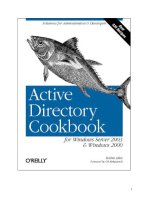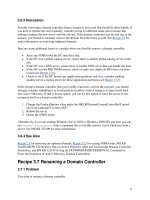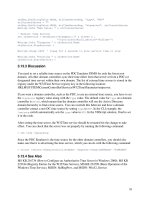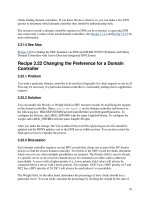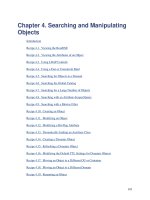Active Directory Cookbook for windows server 2003- P2 pps
Bạn đang xem bản rút gọn của tài liệu. Xem và tải ngay bản đầy đủ của tài liệu tại đây (35.75 KB, 10 trang )
11
\support\toolsdirectory. The Appendix A contains a complete list of the tools used within this
book, where they can be found, and what recipes they are used in.
Once you have the tools at your disposal, there are a couple other issues to be aware of while
trying to apply the solutions in your environment, which I'll now describe.
1.1.1 Running Tools with Alternate Credentials
A best practice for managing Active Directory is to create separate administrator accounts that
you grant elevated privileges, instead of letting administrators use their normal user account that
they use to access other Network Operating System (NOS) resources. This is beneficial because
an administrator who wants to use elevated privileges has to log on with his administrative
account explicitly instead of having the rights implicitly, which could lead to accidental changes
in Active Directory. Assuming you employ this method, then you must provide alternate
credentials when using tools to administer Active Directory unless you log on to a machine, such
as a domain controller, with the administrative credentials.
There are several options for specifying alternate credentials. Many GUI and CLI tools have an
option to specify a user and password to authenticate with. If the tool you want to use does not
have that option, you can use the runas command instead. The following command would run
the enumprop command from the Resource Kit under the credentials of the administrator account
in the rallencorp.com domain:
> runas /user:[RETURN]
/netonly "enumprop \"LDAP://dc1/dc=rallencorp,dc=com\""
To run a Microsoft Management Console (MMC) console with alternate credentials, simply use
mmc as the command to run from runas:
> runas /user: /netonly "mmc"
This will create an empty MMC console from which you can add consoles for any snap-ins that
have been installed on the local computer.
The /netonly switch is necessary if the user you are authenticating with
does not have local logon rights on the machine you are running the
command from.
There is another option for running MMC snap-ins with alternate credentials. Click on the Start
menu and browse to the tool you want to open, hold down the Shift key, and then right-click on
the tool. If you select Run As, you will be prompted to enter credentials to run the tool under.
1.1.2 Targeting Specific Domain Controllers
Another issue to be aware of when following the instructions in the recipes is whether you need
to target a specific domain controller. In the solutions in this book, I typically do not target a
12
specific domain controller. When you don't specify a domain controller, you are using a
serverless bind and there is no guarantee what server you will be hitting. Depending on your
environment and the task you need to do, you may want to target a specific domain controller so
that you know where the query or change will be taking place. Also, serverless binding can work
only if the DNS for the Active Directory forest is configured properly and your client can query
it. If you have a standalone Active Directory environment that has no ties to your corporate DNS,
you may need to target a specific domain controller for the tools to work.
Recipe 1.2 Getting Familiar with LDIF
Even with the new utilities available with Windows Server 2003, support for modifying data
within Active Directory using a command-line tool is relatively weak. The dsmod tool can
modify attributes on a limited set of object classes, but it does not allow you to modify any
object type.
One reason for the lack of command-line tools to do this is the command line is not well suited
for manipulating objects, for example, that have multivalued attributes. If you want to specify
more than just one or two values, a single command could get quite long. It would be easier to
use a GUI editor, such as ADSI Edit, to do the task instead.
The LDAP Data Interchange Format was designed to address this issue. Defined in RFC 2849,
LDIF allows you to represent directory additions, modifications, and deletions in a text-based
file, which you can import into a directory using an LDIF-capable tool.
The ldifde utility has been available since Windows 2000 and it allows you to import and
export Active Directory content in LDIF format. LDIF files are composed of blocks of entries.
An entry can add, modify, or delete an object. The first line of an entry is the distinguished name.
The second line contains a changetype, which can be add, modify, or delete. If it is an object
addition, the rest of the entry contains the attributes that should be initially set on the object (one
per line). For object deletions, you do not need to specify any other attributes. And for object
modifications, you need to specify at least three more lines. The first should contain the type of
modification you want to perform on the object. This can be
add (to set a previously unset
attribute or to add a new value to a multivalued attribute), replace (to replace an existing value),
or
delete (to remove a value). The modification type should be followed by a colon and the
attribute you want to perform the modification on. The next line should contain the name of the
attribute followed by a colon, and the value for the attribute. For example, to replace the last
name attribute with the value Smith, you'd use the following LDIF:
dn: cn=jsmith,cn=users,dc=rallencorp,dc=com
changetype: modify
replace: sn
sn: Smith
-
Modification entries must be followed by a line that only contains a hyphen (-). You can put
additional modification actions following the hyphen, each separated by another hyphen. Here is
13
a complete LDIF example that adds a jsmith user object and then modifies the givenName and
sn attributes for that object:
dn: cn=jsmith,cn=users,dc=rallencorp,dc=com
changetype: add
objectClass: user
samaccountname: jsmith
sn: JSmith
useraccountcontrol: 512
dn: cn=jsmith,cn=users,dc=rallencorp,dc=com
changetype: modify
add: givenName
givenName: Jim
-
replace: sn
sn: Smith
-
See Recipe 4.24 and Recipe 4.25 for more details on how to use the ldifde utility to import and
export LDIF files.
Recipe 1.3 Programming Notes
In the VBScript solutions, my intention was to provide the answer in as few lines of code as
necessary. Since this book is not a pure programming book, I did not want to provide a detailed
explanation of how to use ADSI or WMI. If you are looking for that, I recommend Part 3 of
Active Directory, Second Edition. The intent of the VBScript code is to provide you the basics
for how a task can be automated and let you run with it. Most examples only take some minor
tweaking to make them do something useful for you.
Just as with the GUI and CLI solutions, there are some important issues to be aware of when
looking at the VBScript solutions.
1.3.1 Serverless Binds
I mentioned earlier that in the GUI and CLI examples I did not provide instructions for targeting
a specific domain controller to perform a task. Instead, I rely on serverless binds in most cases.
The same applies to the API solutions. A serverless bind for the RootDSE looks like the
following in VBScript:
set objRootDSE = GetObject("LDAP://RootDSE")
That code will query the RootDSE for a domain controller in the domain of the currently logged
on user. You can target a specific domain instead by simply specifying the domain name in the
ADsPath:
set objRootDSE = GetObject("LDAP://apac.rallencorp.com/RootDSE")
14
And similarly, you can target a specific domain controller by including the server name in the
ADsPath:
set objRootDSE = GetObject("LDAP://dc1/RootDSE")
So depending on how your environment is set up and what forest you want to query, you may or
may not need to specify a domain or server name in the code.
1.3.2 Running Scripts Using Alternate Credentials
Just as you might need to run the GUI and CLI tools with alternate credentials, you may also
need to run your scripts and programs with alternate credentials. One way is to use the runas
method described earlier when invoking the script. A better option would be to use the
Scheduled Tasks service to run the script under credentials you specify when creating the task.
And yet another option is to hardcode the credentials in the script. Obviously, this is not very
appealing in some scenarios because you do not want the username and password contained in
the script to be easily viewable by others. Nevertheless, it is a necessary evil, especially when
developing against multiple forests, and I'll describe how it can be done with ADSI and ADO.
With ADSI, you can use the IADsOpenDSObject::OpenDSObject method to specify alternate
credentials. You can quickly turn any ADSI-based example in this book into one that
authenticates as a particular user. For example, a solution to print out the description of a domain
might look like the following:
set objDomain = GetObject("LDAP://dc=apac,dc=rallencorp,dc=com")
WScript.Echo "Description: " & objDomain.Get("description")
Using OpenDSObject, it takes only one additional statement to make the same code authenticate
as the administrator in the domain:
set objLDAP = GetObject("LDAP:")
set objDomain = objLDAP.OpenDSObject( _
"LDAP://dc=apac,dc=rallencorp,dc=com", _
"", _
"MyPassword", _
0)
WScript.Echo "Description: " & objDomain.Get("description")
It is just as easy to authenticate in ADO code as well. Take the following example, which queries
all computer objects in the apac.rallencorp.com domain:
strBase = "<LDAP://dc=apac,dc=rallencorp,dc=com>;"
strFilter = "(&(objectclass=computer)(objectcategory=computer));"
strAttrs = "cn;"
strScope = "subtree"
set objConn = CreateObject("ADODB.Connection")
objConn.Provider = "ADsDSOObject"
objConn.Open "Active Directory Provider"
15
set objRS = objConn.Execute(strBase & strFilter & strAttrs & strScope)
objRS.MoveFirst
while Not objRS.EOF
Wscript.Echo objRS.Fields(0).Value
objRS.MoveNext
wend
Now, by adding two lines (shown in bold), we can authenticate with the administrator account:
strBaseDN = "<LDAP://dc=apac,dc=rallencorp,dc=com>;"
strFilter = "(&(objectclass=computer)(objectcategory=computer));"
strAttrs = "cn;"
strScope = "subtree"
set objConn = CreateObject("ADODB.Connection")
objConn.Provider = "ADsDSOObject"
objConn.Properties("User ID") = ""
objConn.Properties("Password") = "MyPassword"
objConn.Open "Active Directory Provider"
set objRS = objConn.Execute(strBaseDN & strFilter & strAttrs & strScope)
objRS.MoveFirst
while Not objRS.EOF
Wscript.Echo objRS.Fields(0).Value
objRS.MoveNext
wend
To authenticate with ADO, you need to set the User ID and Password properties of the ADO
connection object. I used the UPN of the administrator for the user ID. With ADSI and ADO,
you can use a UPN, NT 4.0 style account name (e.g., APAC\Administrator), or distinguished
name for the user ID.
1.3.3 Defining Variables and Error Checking
An important part of any script is error checking. Error checking allows your programs to
gracefully identify any issues that arise during execution and take the appropriate action. Another
best practice is to define variables before you use them and clean them up after you are done
with them. In this book, most of the programmatic solutions do not include any error checking,
predefined variables, or variable clean up. While admittedly this is not setting a good example, if
I included extensive error checking and variable management, it would have made this book
considerably longer with little value to the reader. Again, the goal is to provide you with a code
snippet that shows you how to accomplish a task, not provide robust scripts that include all the
trimmings.
Error checking with VBScript is pretty straightforward. At the beginning of the script include the
following declaration:
On Error Resume Next
This tells the script interpreter to continue even if errors occur. Without that declaration, anytime
an error is encountered the script will abort. When you use
On Error Resume Next, you need to
16
use the Err object to check for errors after any step where a fatal error could occur. The
following example shows how to use the Err object.
On Error Resume Next
set objDomain = GetObject("LDAP://dc=rallencorp,dc=com")
if Err.Number <> 0 then
Wscript.Echo "An error occured getting the domain object: " &
Err.Description
Wscript.Quit
end if
Two important properties of the Err object are Number, which if non-zero signifies an error, and
Description which will contain the error message.
As far as variable management goes, it is always a good practice to include the following at the
beginning of every script:
Option Explicit
When this is used, every variable in the script must be declared or an exception will be generated
when you attempt to run the script. Variables are declared in VBScript using the Dim keyword.
After you are done with a variable, it is a good practice to set it to Nothing so you release any
resources bound to the variable, and don't accidentally re-use the variable with its previous value.
The following code shows a complete example for printing the display name for a domain with
error checking and variable management included:
Option Explicit
On Error Resume Next
Dim objDomain
set objDomain = GetObject("LDAP://cn=users,dc=rallencorp,dc=com")
if Err.Number <> 0 then
Wscript.Echo "An error occured getting the domain object: " &
Err.Description
Wscript.Quit
end if
Dim strDescr
strDescr = objDomain.Get("description")
if Err.Number <> 0 then
Wscript.Echo "An error occured getting the description: " &
Err.Description
Wscript.Quit
end if
WScript.Echo "Description: " & strDescr
objDomain = Nothing
strDescr = Nothing
17
Recipe 1.4 Replaceable Text
This book is filled with examples. Every recipe consists of one or more examples that show how
to accomplish a task. Most CLI- and VBScript-based solutions use parameters that are based on
the domain, forest, OU, user, etc., that is being added, modified, queried, and so on. Instead of
using fictitious names, in most cases, I use replaceable text. This text should be easily
recognizable because it is in italics and surrounded by angle brackets (<>). Instead of describing
what each replaceable element represents every time I use it, I've included a list of some of the
commonly used ones here:
<DomainDN>
Distinguished name of domain (e.g., dc=amer,dc=rallencorp,dc=com)
<ForestRootDN>
Distinguished name of the forest root domain (e.g., dc=rallencorp,dc=com)
<DomainDNSName>
Fully qualified DNS name of domain (e.g., amer.rallencorp.com)
<ForestDNSName>
Fully qualified DNS name of forest root domain (e.g., rallencorp.com)
<DomainControllerName>
Single label or fully qualified DNS hostname of domain controller (e.g.,
dc01.rallencorp.com)
<UserDN>
Distinguished name of user (e.g., cn=administrator,cn=users,dc=rallencorp,dc=com)
<GroupDN>
Distinguished name of group (e.g., cn=DomainAdmins,cn=users,dc=rallencorp,dc=com)
<ComputerName>
Single label DNS hostname of computer (e.g., rallen-xp)
Recipe 1.5 Where to Find More Information
While it is my hope that this book provides you with enough information to perform most of the
tasks you need to do to maintain your Active Directory environment, it is not realistic to think
18
every possible task has been covered. In fact, there is easily another three to four chapters I could
have included in this book, but due to space and time considerations, it was not possible for this
edition. Working on this book has made me realize just how must stuff Active Directory
administrators need to know.
Now that Active Directory has been around for a few years, a significant user base has been built,
which has led to other great resources of information. This section contains some of the useful
sources of information that I use on a regular basis.
1.5.1 Command-Line Tools
If you have any questions about the complete syntax or usage information for any of the
command-line tools I use, you should first take a look at the help information for the tools. The
vast majority of CLI tools provide syntax information by simply passing /? as a parameter. For
example:
> dsquery /?
1.5.2 Microsoft Knowledge Base
The Microsoft Support web site is a great source of information and is home of the Microsoft
Knowledge Base (MS KB) articles. Throughout the book, I include references to pertinent MS
KB articles where you can find more information on the topic. You can find the complete text for
a KB article by searching on the KB number at the following web site:
You can also append the KB article number to the end
of this URL to go directly to the article:
1.5.3 Microsoft Developers Network
MSDN contains a ton of information on Active Directory and the programmatic interfaces to
Active Directory, such as ADSI and LDAP. I sometimes reference MSDN pages in recipes.
Unfortunately, there is no easy way to reference the exact page I'm talking about unless I
provided the URL or navigation to the page, which would more than likely change by the time
the book was printed. Instead I provide the name of the title of the page, which you can use to
search on via the following site:
1.5.4 Web Sites
Microsoft Active Directory Home Page (
This site is the starting point for Active Directory information provided by Microsoft. It
contains links to white papers, case studies, and tools.
Microsoft Webcasts ( />)
Webcasts are on-demand audio/video technical presentations that cover a wide range of
Microsoft products. There are several Active Directory-related webcasts that cover such
19
topics as disaster recovery, upgrading to Windows Server 2003 Active Directory, and
Active Directory tools.
Google Search Engine (
Google is my primary starting point for locating information on Active Directory. It is a
powerful search engine and is often quicker and easier to use to search the Microsoft web
sites than using the search engines provided on Microsoft's sites.
LabMice Active Directory (
The LabMice web site contains a large collection of links to information on Active
Directory. It has links to MS KB articles, white papers, and other web sites.
Robbie Allen's Home Page (
This is my personal web site, which has information about the Active Directory books
I've written and links to download the code contained in each (including this book).
1.5.5 Newsgroups
microsoft.public.win2000.active_directory
This is a very active newsgroup where several top-notch Active Directory experts answer
questions posed by users.
microsoft.public.win2000.dns
This is another good resource if you have a DNS question you've been unable to find an
answer for; odds are someone on this newsgroup will have an answer.
microsoft.public.adsi.general
If you have questions about ADSI, this is another very active newsgroup where you can
find answers.
If you have a question about a particular topic, a good starting point is to search the newsgroups
using Google's Groups search engine ( />). Just like its web search engine,
the group search engine is very fast and is an invaluable resource when trying to locate
information.
1.5.6 Mailing Lists
ActiveDir (
The ActiveDir mailing list is where the most advanced Active Directory questions can
get answered. The list owner, Tony Murray, does an excellent job of not allowing topics
to get out of hand as can sometimes happen on large mailing lists. The list is very active
20
and it is rare for a question to go unanswered. Some of Microsoft's Active Directory
Program Managers also participate on the list and are very helpful with the toughest
questions. Keeping track of this list is a must-have for any serious Active Directory
administrator.
15 Seconds (
Just as the ActiveDir list is crucial for AD administrators, the 15 seconds list is extremely
valuable for AD developers. It is also very active and the participants are good about
responding to questions quickly.
1.5.7 Books
In addition to the Resource Kit books, the following books are good sources of information:
Active Directory, Second Edition, by Robbie Allen and Alistair Lowe-Norris (O'Reilly)
This is a good all-purpose book on Active Directory. A few of the topics the second
edition cover include new Windows Server 2003 features, designing Active Directory,
upgrading from Windows 2000, and Active Directory automation.
Managing Enterprise Active Directory Services, by Robbie Allen and Richard Puckett (Addison-
Wesley)
This is a great resource for anyone who has to support a large-scale Active Directory
environment. The book preaches the benefits of automation in large environments and
includes over 300 sample scripts written in Perl and VBScript.
Active Directory Programming, by Gil Kirkpatrick (MacMillan)
This is a great book for those interested in learning the details of ADSI and LDAP
programming. The author, Gil Kirkpatrick, is a noted expert in the field.
1.5.8 Magazines
Windows & .NET Magazine (
This is a general-purpose monthly magazine for system administrators that support
Microsoft products. The magazine isn't devoted to Active Directory, but generally there
are related topics covered every month.
Windows Scripting Solutions (
This is a useful monthly newsletter that discusses automation scripts on a wide variety of
Microsoft products including Active Directory.
